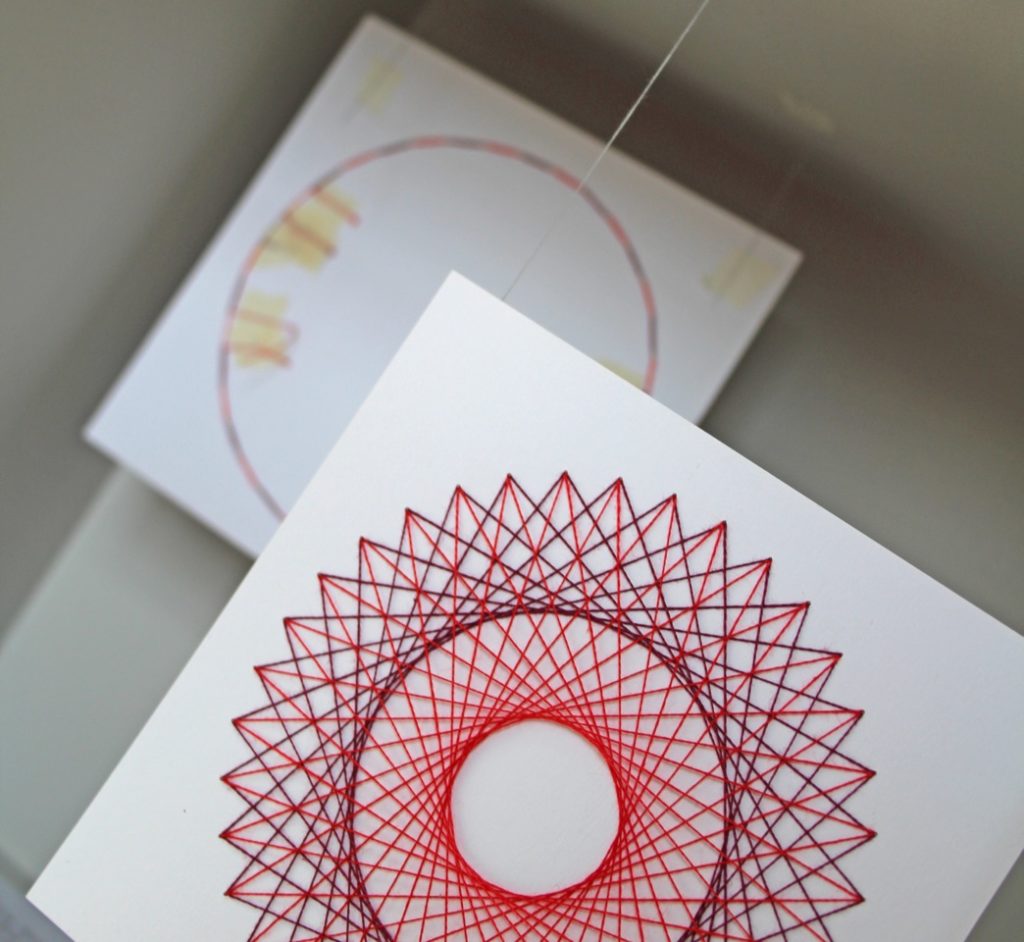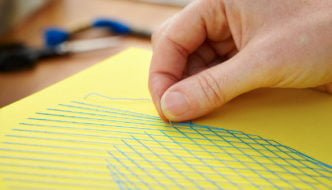Interview: Alison McIntyre discusses her current show ‘Threads’ at Colours May Vary
June 20, 2016

All images credited to Alison McIntyre
TSOTA: Talk us through your current project and exhibition ‘Threads’, how did it come about?
A: I’ve been making curve stitched pictures, cards etc commercially for about 3 years now and really wanted to link the technique back into my community work. I’ve also always been interested in how different the dynamics are in groups when we are working together on creative projects. So the idea for the project came out of wanting to explore through a community project that would use curve stitching as a technique.
TSOTA: How important is collaboration and community involvement to your practise?
A: I have been running community projects since 2003 and have always enjoyed the balance between community and commercial practice. This is the first project where I feel I have really involved and been influenced by the participants, rather than just turning up and delivering some workshops or similar. Sometimes that is all there is capacity and funding to achieve and there is great value in people being able to join in with arts activities, whatever the format. However the many different aspects and stages of this project mean I have got to know the participants quite well and the value we have gained from it has been more profound.
Collaborating is a wonderful way to work. Of course it has its own issues and difficulties but I find it an extremely rewarding experience. I think it’s particularly important to collaborate on community projects so that there are checks and balances in place to keep you from straying from your original ideas and plans (artists are usually pretty high on ego). It’s also brilliant to have support from people who know the project well, but who are slightly more outside it than you will inevitably become; someone to talk to when you get to the point when you’re not sure any longer whether what you’re doing is brilliant or just a bit rubbish.
So much happens and gets decided as you go along and the more people involved the more input there is into that process. As long as people are aware that not everything they come up with can be included, and as long as you have a strong overall vision so that you can make those decisions easily, it’s a wonderful and enriching experience.

TSOTA: How have you seen your ideas and concepts develop through the involvement of others and the influence of collaboration?
A: At the start of the project, when I was writing the funding bid, I talked a lot about the people I was planning to work with and at this point they are this amorphous group who had no identity. In January, once people started to sign up and make work for the exhibition they became very real people with their own ideas and creative sensibilities. I think at the start I wanted to keep control of the creative process as much as possible, but as I got to know the participants I really started to trust them and allow them a lot of freedom to interpret and develop the technique if they wanted to. I think the exhibition is far better because of this approach, even pieces that weren’t as precise and ‘perfect’ as I need my commercial work to be were included in the exhibition. On their own this might be noticeable but together we just see the whole effect and don’t notice any slight errors, it was only after putting everything together that I realised what a great representation this was of how the groups worked together and supported each other through the process of the project.
TSOTA: The idea of documenting and displaying the conversations that have taken place during the journey of the Threads project is fresh and engaging- is the process of creation equally as important to you as the final outcome?
A: Yes absolutely. The idea came from teaching workshops, particularly with older people through Heydays at the West Yorkshire Playhouse, where I started out trying to teach at every moment of the sessions. They soon whipped me into shape and I realised that the sessions were about so much more than learning or creating something at the end. Feeling a sense of achievement is important and I wanted the exhibition to be something that everyone would feel very proud of.
However sitting, talking, spending time together and just doing and making for the sake of it are things we rarely allow ourselves time for, but are very good for us.
Throughout my career in community arts I have become more and more focussed on process rather than end product, it gives much more space for interesting diversions, creativity and collaborative problem solving. And I think you get a better end product this way too.
TSOTA: What do you hope / see this current project and your other community engagements will lead on to?
A: I’m mulling over a few thoughts currently but I think crafts are a great access point for people to engage with the arts who may not have done previously. I’d quite like to do similar projects to Threads but maybe with different crafts as a starting point.
I’m also involved in some other engagement projects like the Art Doctors for the British Art Show where we prescribe pieces of work for visitors to engage with, depending on our diagnosis of their art needs. We’ve already followed the exhibition to Edinburgh and are hoping to also visit Norwich and Southampton.
So it would be great to get some more freelance work as a result of either Threads or Art Doctors.

TSOTA: How can people get involved in your work?
A:There aren’t any current projects to get involved with at the moment but anyone wanting to get involved in future can sign up to my newsletter here – I won’t bombard you with emails but will send out info about opportunities and projects I’m involved with every few months or so.
You can also buy my work online through Folksy
TSOTA: What is coming up next for you in 2016?
A: I will be very much focussing on the commercial work in the run up to Christmas, hopefully getting a few more stockists, getting some new products online and doing some craft fairs. Then hopefully a couple more Art Doctor prescribing sessions for the British Art Show in Norwich and Southampton, and whatever other freelance work comes my way. And inevitably making plans and writing funding applications for whatever I decide the next big project will be.
Threads is on at Colours May Vary until 10th July.
Filed under: Art & Photography
Tagged with: Threads

Comments